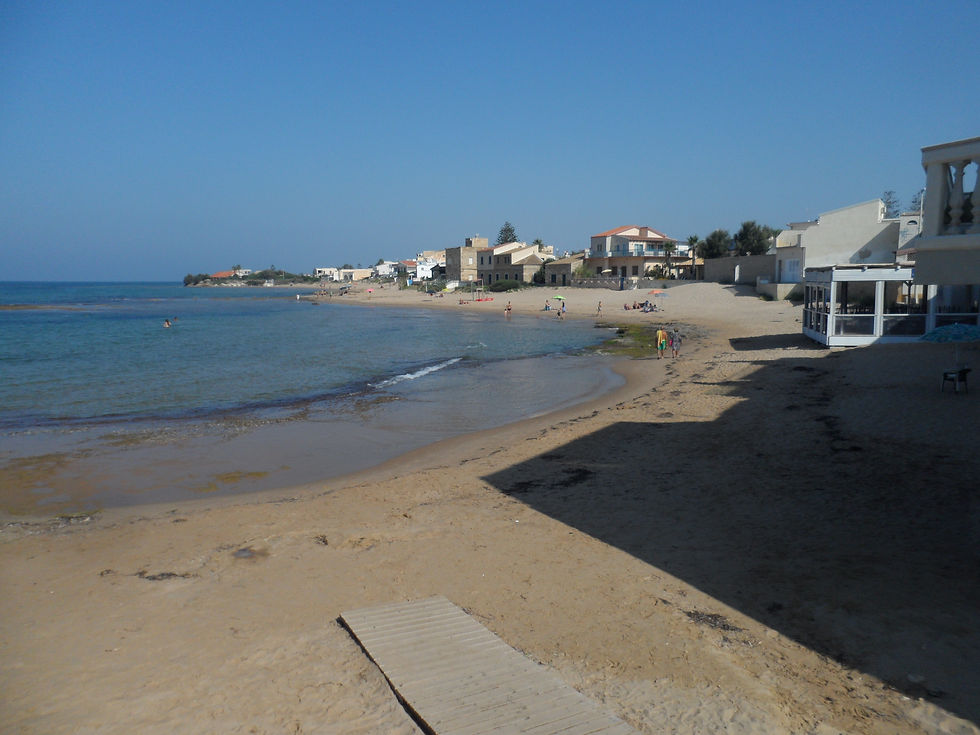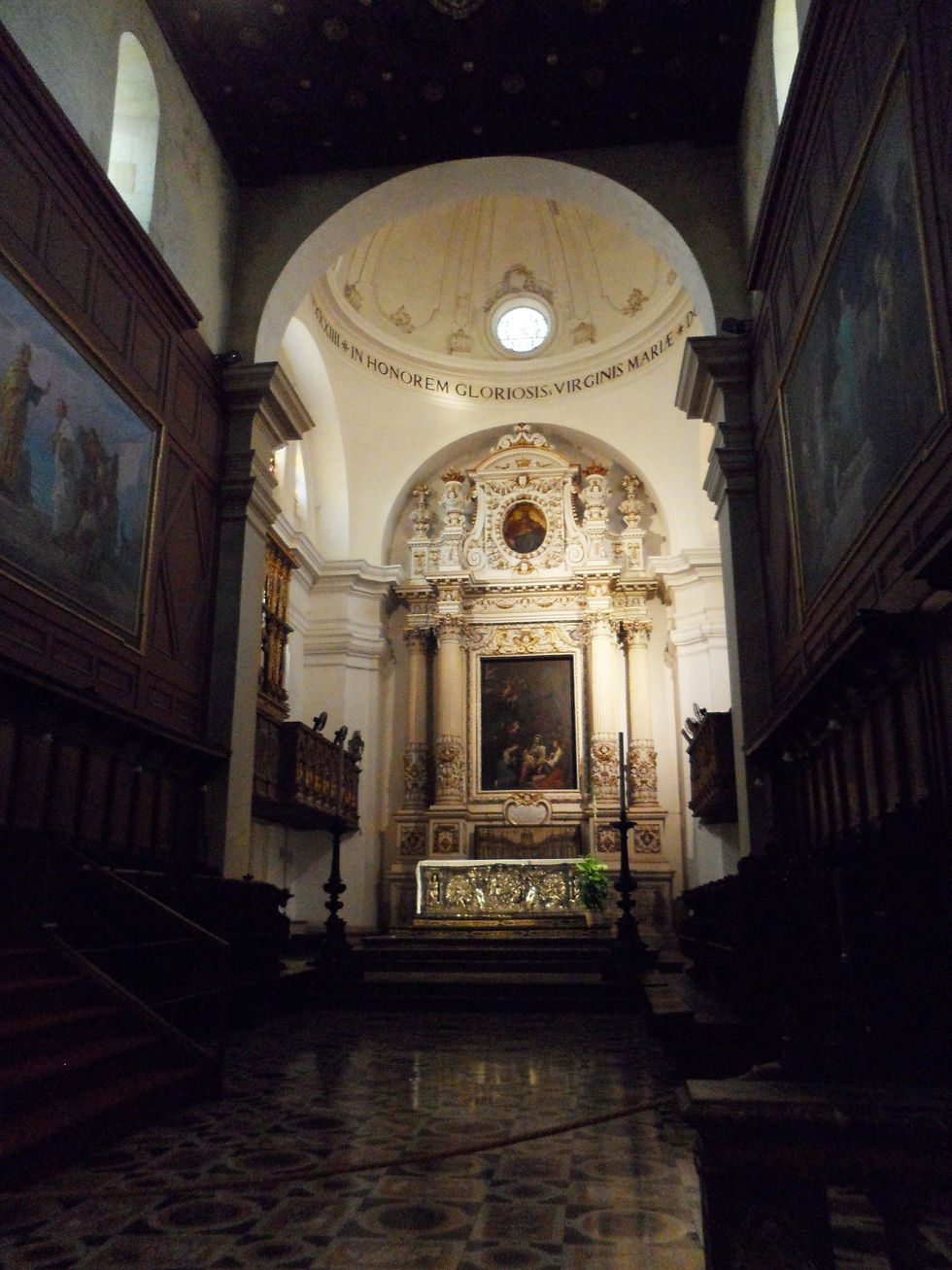Eastern Sicily between theaters, baroque churches and Montalbano
- Angelo e Adele
- Oct 5, 2019
- 7 min read
Updated: Jan 2, 2023
Here we are again to you, to give you the report of another beautiful trip to Sicily, carried out in the week between 16 and 23 September 2019 with the impeccable organization of one of our trusted tour operators, Planet Viaggi. The tour took place between the provinces of Ragusa, Syracuse, Catania and Messina, with overnight stays in Modica, Syracuse and Aci Castello; Montalbano, baroque, classical antiquities, Etna and various delicacies were the distinctive features of this trip. We were six people, three of which in wheelchairs, and we moved in a minibus, guided by our excellent guide Paolo, whom we thank for the assistance given to us and also for the contribution to the photographic material. We started with Montalbano; in fact, the first destination was the locality of Puntasecca, where the famous inspector's house on the sea stands, now used as a bed & breakfast; if you want, the beach is accessible by wheelchair:



the statue to Andrea Camilleri, the author of Montalbano's novels, was a must:



The Montalbanian tour continued with a visit to SCICLI, a city very rich in Baroque, like all those in the area, but rather difficult for those who travel by wheelchair. But the Town Hall, or the entrance to the Vigata police station for Montalbano fans, we could see:

other images of churches of Scicli:


One of the highlights of this trip was the visit to MODICA, a city whose first traces date back to the third century BC, when it fiercely opposed the Romans; with the Arabs and the Normans it subsequently flourished for trade and agriculture, until the period in which the noble families enriched it with elegant baroque residences. Even the historic center of Modica is all ups and downs; we were able to visit the Cathedral of San Pietro, accessible thanks to an elevator:



But the most touching experience was undoubtedly the visit to the rock church of San Nicolò Inferiore, dating back to the 11th-12th century but discovered only in 1987 and in a completely casual way; cleared of the rubble which had filled up over the centuries, this truly moving cycle of Byzantine frescoes appeared:


the Christ Pantocrator:

But now let's talk about the two extra artistic experiences that characterized our visit to Modica. The first was a visit to Casa Don Puglisi (www.casadonpuglisi.it), a voluntary association that since 1990 has hosted mothers and children in difficult situations in an ancient building in the center of Modica. Meeting these people was one of the most intense moments of our tour:


The delicacies that can be glimpsed on the table lead us immediately to the other special visit made in that of Modica, namely the incursion to the Quetzal Cooperative (www.cioccolato-quetzal.it), which produces the very famous Modica chocolate, buying the raw materials from producers in the South of the world within a fair and solidarity circuit. We were shown the history of Modica chocolate, the company's processing cycle and we were able to make various tastings; we finished in glory with the purchase of Quetzal products in their store:


A last look at Modica at sunset:

Let's now pass to Ragusa, or rather IBLA, the ancient city rebuilt on itself after the earthquake of 1693; we climbed up to the Cathedral, dedicated to San Giorgio and accessible thanks to a providential elevator:



a look at the Circolo di Conversazione, a meeting place of the Ragusan aristocracy, still active today, in which the scenes were shot in which Montalbano goes to break the "cabbasisi" to dr. Pasquano who is playing cards:

And we close the visit to Ibla with the Ibleo Garden, a beautiful panoramic park built in the nineteenth century:

inside the Ibleo Garden the Church of the Capuchins with the beautiful seventeenth-century altarpiece by Pietro Novelli:


But the capital of the Baroque, according to the Council of Europe, as well as a UNESCO World Heritage Site, is NOTO. The new city was founded in 1703, south-east of the existing one, destroyed by the terrible earthquake of 1693. Not even Noto is very easy in a wheelchair, due to some rather steep slopes; however you can easily walk along the main artery, Corso Vittorio Emanuele, long, straight and paved with smooth stone, and visit the Cathedral dedicated to San Nicolò:



and this is a wooden cross made in 2016 by prof. Elia Li Gioi with the remains of migrant boats collected on Sicilian beaches:

Continuing along Corso Vittorio Emanuele we meet the splendid Church of San Domenico, with its small nineteenth-century garden in front of the facade:


We leave Noto and the province of Ragusa to go to SYRACUSE a city founded in the eighth century BC. by a group of Corinthians, but whose first human settlements date back to the fourteenth century BC, located on the island of ORTIGIA. This is in fact the old part of the city and it is advisable to visit it by parking your vehicle and entering the alleys in a wheelchair. The first stop was Piazza del Duomo, a majestic Baroque setting closed between a straight side designed by the facade of the Cathedral and on the opposite side by the curved line of the buildings:


The Cathedral (accessible by wheelchair from a side entrance which is opened upon request) was built on a Doric temple from the 5th century BC, whose columns are incorporated into the walls and are clearly visible; transformed into a Christian church by the Byzantines, it was enlarged by the Normans and rebuilt in Sicilian Baroque style in 1700, after several earthquakes. Some pictures:



Leaving Piazza del Duomo we continue on the Lungomare Alfeo, from which you can see the end of the island with the Maniace Castle:

But before arriving at the castle, we stop to admire the Fonte Aretusa, a millenary spring of fresh water that today gushes brackish due to the infiltration of sea water. The semicircular basin, verdant with papyrus, was only built in 1843:


At the end of the promenade we arrived at the Maniace Castle, a square fortification built by Frederick II of Swabia in 1239; there would be much more to see in Ortigia, but a violent storm put us on the run. We hope that some of our readers can come and give us a full account of this delightful island.

But the most famous area of Syracuse is the Archaeological Park of Neapolis, which encloses in an area of 200,000 square meters most of the classical monuments of the Greek-Roman age, starting with the Greek Theater:


continuing with the Ear of Dionysius, an artificial cave with extraordinary acoustic properties; hence the legend of the tyrant Dionysius who listened to the speeches of the prisoners locked up there by an opening on the top of the cave:

we continue with the Ara di Ierone, an altar for public sacrifices built by the tyrant Ierone II in the period of peace following the Punic wars:

to conclude with the Roman Amphitheater, one of the largest among those present on Italian soil after the Colosseum:


The visit to the archaeological park is completed with the splendid Paolo Orsi Regional Archaeological Museum, located inside the green park of Villa Landolina; the museum collects an immeasurable quantity of finds from all civilizations and peoples that have followed one another in Syracuse from prehistoric times to the early Christian age. Too bad that the elevators for the basement and the first floor were out of order and therefore our visit had to be limited to the ground floor; however the richness of the pieces exhibited in these sections is immense, as we will try to show you with the images:












Let's now pass to CATANIA, an imposing city full of large streets, squares and monuments. Let's look at some pictures, starting with the Cathedral dedicated to Sant'Agata:


the Elephant Fountain:


and in the same square the Amenano Fountain:

But the funniest thing of the day in Catania was the Street Food Tour "La Via dell'Elefante", in which we were led by a guide from Sicilying (www.sicilying.com) on a 6-stage tasting tour of the delights of Catania street food, to be precise: typical cheeses, fried fish, rice arancini, cipollina (a kind of focaccia), seltzer drinks, granitas and minnuzza (small almond sweets).

The tour took place in the alleys of the Catania market, Via Etnea, the Bellini Gardens, combining gastronomy and monuments:







On the way, take a look at the Roman Amphitheater:

and a stop at the Bellini Gardens:


After the gastronomic tour, we reached the thirteenth-century Ursino Castle, built by Frederick II of Swabia and now used as a civic museum; to commend the work done in the structure of the castle for accessibility to the disabled:

An exhibition of antique movable frontals was in progress in the museum; these are those decorations that cover the front of the altars and these in particular were made with extensive use of silver, coral, garnets and gold threads:





and this is the ancient Greek statue reconstructed by reassembling the pieces according to complex and avant-garde techniques, illustrated in a series of panels covered by the exhibition "The Kouros found":

Let's talk now about the ETNA trip. We arrived easily with the minibus at about 1800 meters, hoping to be able to take the cable car; however, we discovered that there was only one cabin accessible by wheelchair and, considering that the climb takes about 20 minutes, bringing up three chairs and bringing them down would have required two hours to go and the same amount to return. We then limited ourselves to stopping on the terrace of the bar, while the companions visited the sylvan craters nearby:




And we close this tour with a visit to TAORMINA, a fascinating city with a high tourist level; for us, however, it proved to be quite prohibitive because, beyond Corso Umberto I, comfortable and easy to travel, and the splendid Greek Theater, all the other monuments and most of the shops are inaccessible by wheelchair. So we show you some pictures of our walk from one door of the city to another, with a visit to the Greek Theater, of which we were at least able to reach the stalls, while our companions climbed the steps to take photos of the splendid views. enjoying from above:




and this is the spectacular glance that presented itself to us from the terrace of the Hotel Timeo:


Let's now enter the Greek Theater:




In conclusion, this second trip to Sicily confirmed the enthusiasm for this land, its monuments, its nature, its food, all inserted in a context that, for those who move in a wheelchair, always requires a degree of attention and preparation that "our" tour operator Planet Viaggi guaranteed us this time too.

Comments